DON’T LET THE BED BUGS BITE
Despite their role in an adorable bedtime proverb, bed bugs are pesky little pests. They sneak into your bed, your furniture, even your carpet, and while you sleep or watch TV, they bite you. The next morning, you’re left wondering why you’re red and itchy.
Bed bugs are small, flat, oval-shaped insects. They do not have wings and rely on humans to carry them from one place to the next.
Bed bugs are a reddish-brown color and can be between 1 and 7 millimeters.
They feed on blood from humans or animals, and they’re most active at night, feeding on their victims while they sleep.


Some people will not experience a reaction to a bed bug bite at all. Those that do experience symptoms of a bite are likely to experience one or more of the following:
- a bite with a red, swollen area and a dark red center
- bites in a line or grouped together in a small area
- blisters or hives at the bite site
Bites can happen anywhere on the body. Most commonly they occur on areas of skin that are exposed while sleeping, such as the face, arms, legs, and hands.
What are the symptoms of a Bed Bug bite?
- Bed bug bites don’t always appear immediately after you’re bitten. They sometimes take a few days to begin causing symptoms. It should also be noted that bed bugs don’t come out to feed every single night. In fact, they can go several days without eating. It may take a few weeks to notice that your bites are part of a larger pattern.Bed bug bites are often very itchy. You may experience a burning sensation on the skin several days after you’ve been bitten. You won’t feel the bugs bite you because they excrete a tiny amount of anesthesia into your body before they bite.If you scratch the bite, you may cause a secondary infection that can lead to swelling and bleeding.
Where are Bed Bugs found?
If you suspect that you have bed bug bites, it’s important to look into the matter. Waiting for more bites prolongs the problem. Bed bugs were once rare, but in recent years, there’s been a surge in population.
Bed bugs are most common in facilities that have a lot of people, a lot of turnover, and close quarters. However, they can also come into your home if brought there. Listed below are the places that most commonly have bed bugs:
- hotels
- hospitals
- homeless shelters
- military barracks
- college dorms
- apartment complexes
- business offices
I have Bed Bugs in my home, how will I know?
Bed bugs like to hide where you sleep. If you find bites and suspect bed bugs, search around for them. You may not see the bugs themselves, but you might see tiny black dots (their droppings) or red smears, signs they’ve been biting you.
Most common hiding sites for bed bugs in your home:
- bed frame
- headboard
- mattress
- box springs
- pillows
- bed skirts
- in the crevices and seams of furniture
- in carpeting at baseboards or under furniture
- in curtains or other fabrics
How are bed bug bites treated?
Bed bugs are more annoying than they are dangerous or deadly. The symptoms of a bite typically disappear in one to two weeks. Use an anti-itch cream to keep yourself from itching the bite. Take an antihistamine to help reduce the itching and burning. Ice packs can help numb the skin and reduce your urge to scratch. Use an antiseptic cream or lotion if you get an infection.
Get rid of Bed Bugs for good!
If you find bed bugs in your home, call your landlord or pest control company to have your home treated. Getting rid of bed bugs yourself is hard, and you may prolong infestation if you do not get professional treatment. Bed bugs can hide for several months without feeding, so getting a professional treatment can help you make sure you’re getting rid of the blood-sucking pests completely.
Your AR ant Pest Control office has products developed for the control of pests such as Ants. Due to the potential danger of property damage, it is advisable to contact an AR Service Representative at (905) 670-7378 or info@arpestcontrol.ca
- Mosquitos siphon blood from their victims,
- Their saliva contains proteins that most people are allergic to
- You immune systems springs into action causing a round, bump that will appear immediately after you’ve been bitten
- the bump will soon become red, hard and swollen
- you may have multiple bites in the same area
How should you treat a Mosquito Bite?
- Treat the bite or bites with soap and warm water.
- You can use over the counter pain reliever, antihistamines or topical anti-itch medication to control itches and possibly pain.
- If you have a child with itchy mosquito bites, make sure they keep their fingernails short and remind them not to scratch.


Are most spiders poisonous?
- The majority of the 3,000 spiders in the United States aren’t poisonous. Even if most spiders did bite, their fangs are too small or weak to puncture human skin. Their bites may leave itchy, red wounds that heal within a week or so.The spiders that do manage to bite through our skin and insert toxic venom can cause serious health complications. Read on to learn what spider bites look like, what varieties of spider leave certain bites, and how to treat spider bites.
What do spider bites look like?
Identifying a spider bite is easiest if you saw the spider that bit you, but it’s possible that you won’t notice the wound until hours later. Look for things like swelling, a red welt, skin damage, and any troubling symptoms that accompany the bite.
Other possible symptoms that accompany spider bites include:
- itching or rash
- pain around the area of the bite
- muscle pain or cramping
- blister that’s red or purple in color
- sweating
- difficulty breathing
- headache
- nausea and vomiting
- fever
- chills
- anxiety or restlessness
- rashes
- swollen lymph glands
- high blood pressure
Spider bites often take longer to heal than other insect bites, and they may affect skin tissues. It’s important to keep the bite clean to reduce the risk of infection.
How to treat a spider bite at home
In some cases, you can treat spider bites at home. For nonvenomous spider bites, follow these steps:
- Elevate the area to reduce swelling.
- Take an antihistamine to help with itching.
- Clean the area to prevent infection.
- Apply antibiotic ointment to the area if blisters develop.
Seek medical attention if you’re showing symptoms of a spider bite or if the symptoms don’t go away over time.
Always seek medical attention if you suspect you’ve been bitten by one of the following species:
- brown recluse
- black widow
- hobo spider
- tarantula
- Brazilian wandering spider
About an inch long and usually nonaggressive, the brown recluse typically hides in dark, secluded spaces. It only bites if it’s trapped against your skin. It’s also called the “violin” spider because of the dark marking on its back.
The brown recluse is usually found in areas such as:
- Missouri
- Tennessee
- Kansas
- Arkansas
- Louisiana
- Oklahoma
- eastern Texas

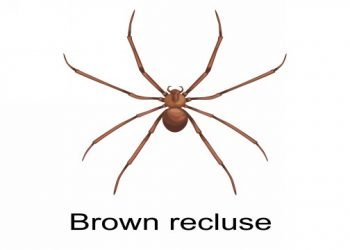
Brown recluse bite
The initial brown recluse bite may be painless, but within eight hours it will begin to itch, hurt, and turn red. A red or purple ring resembling a target or bull’s-eye will develop around the bite. This bite can blister and grow progressively worse without treatment, to the point where it may kill surrounding tissue and cause fever, chills, and headache.
On rare occasions it can cause
On rare occasions it can cause:
- coma or seizures
- jaundice
- blood in urine
- kidney failure
There is no antidote for a brown recluse bite, but treatment like keeping the area clean can encourage faster healing. Your doctor will examine the bite and prescribe antibiotics. In extreme cases, such as tissue death, you will need surgery and hospitalization.

Black widow
- The black widow spider is shiny and black with a distinct, reddish, hourglass-shaped mark on its belly. Found mostly in the warm southern and western states, the black widow stays in secluded spaces like piles of fallen leaves, woodpiles, and boxes in the attic.Only the female black widow is toxic. Black widow bites can feel like a small pinprick or nothing at all, but your skin’s reaction will be immediate and you’ll be able to see the two puncture marks on your skin.
Symptoms of a black widow bite include:
- muscle cramping
- pain and burning at puncture site
- headache
- high blood pressure
- increase saliva and sweating
- nausea and vomiting
- numbness
- restlessness
Prompt treatment is best, especially for children and older adults. In some cases, a healthcare professional will prescribe antivenin to remove the venom from your body.
How to treat a spider bite at home
In some cases, you can treat spider bites at home. For nonvenomous spider bites, follow these steps:
- Elevate the area to reduce swelling.
- Take an antihistamine to help with itching.
- Clean the area to prevent infection.
- Apply antibiotic ointment to the area if blisters develop.
Seek medical attention if you’re showing symptoms of a spider bite or if the symptoms don’t go away over time.
Always seek medical attention if you suspect you’ve been bitten by one of the following species:
- brown recluse
- black widow
- hobo spider
- tarantula
- Brazilian wandering spider
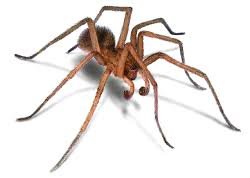
Hobo spider
- Hobo spiders are common in the Pacific Northwest. They sit up high on long legs and run fast. Watch out if you’re cleaning window wells or sweeping out the garage, as they may attack when provoked. Hobo spiders lurk behind furniture, under baseboards, and in closets.
Hobo spider bite
- A bite from a hobo spider may be unnoticeable at first, but it will cause pain and numbness within 15 minutes. After one hour, the site will start to turn red. In eight hours, it will become hardened and swollen. After 24–26 hours, the wound may discharge fluids and eventually turn black.
- Other signs and symptoms may include:
- a red or purple blister at the puncture site
- visual or aural disruption
- weakness
- joint pain
- low blood cell count
- headaches
- nausea
- sweating
Hobo spider bites are slow to heal. Seek immediate medical treatment if you suspect you’ve been bitten by a hobo spider. The treatment is similar to that of brown recluse spider bites and may involve corticosteroids, antibiotics, or surgery. It also works best if administered within 24 hours of the bite.
Common all over the country, wolf spiders measure three to 4 inches long and look similar to tarantulas. They like to stalk their prey by hunting on the ground, and you’ll find them in sand and gravel, around the bases of doors and windows, or in house plants. Look for two large eyes in the middle of their faces, accompanied by six smaller eyes.
A wolf spider’s bite may tear the skin and cause pain, redness, and swelling. You may also experience swollen lymph glands as a result of the bite. For some people, healing can take up to 10 days. In rare cases, the bite can cause tissue damage.
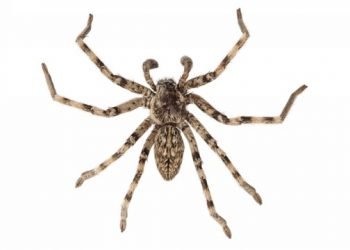

Jumping spider
- One of the most common household spiders, the jumping spider exists throughout the United States. Usually only a half-inch long, it has a stout, hairy body. The most common type is black with white spots on top. It moves erratically in a manner that resembles jumping.
Serious symptoms
- You’re likely to find it outside in gardens and near other vegetation.The jumping spider’s bite is usually no worse than a wasp sting. It can be poisonous if you’re allergic to spider venom.Serious symptoms include:
- pain
- itching
- redness
- swelling
- headaches
They will attack if threatened, so use gloves when gardening.

Fly bites
- Deer flies are about 1/4 to 1/2 of an inch long, with brownish-black bands on their otherwise transparent wings. They may have gold or green eyes on their small, rounded heads.They are most active during spring and like to be near lakes, swamps, or other bodies of water. The larvae resemble maggots.
Deer fly bites are painful
- Deer fly bites are painful, and will cause red bumps or welts. They transmit a rare bacterial disease known as rabbit fever (tularemia). Symptoms include skin ulcers, fever, and headache. Tularemia can be successfully treated with antibiotics, but without treatment, it can be fatal.
How should you treat a Deer Fly Bite?
- To treat deer fly bites, clean the affected area with soap and water. You can apply ice to the area to treat pain. You can also take allergy medicine like diphenhydramine(Benadryl) to reduce itching, which can prevent secondary infection.

Black Fly
- Black flies are small, ranging from 5 to 15 millimeters as adults. They have an arched thoracic region, short antennae, and wings that are large and fan-shaped.They are often found near bodies of water where their larvae grow.Black flies can be found throughout most of the United States, but their bites do not appear to transmit diseases here.In other regions of the world, including Africa and South America, their bites can transmit a disease called “river blindness.”
Symptoms
- Black flies typically bite near the head or face. Their bites leave a small puncture wound, and can result in anything from slight swelling to a swollen bump the size of a golf ball. Other symptoms can include headaches, nausea, fever, and swollen lymph nodes. When these symptoms occur, they’re referred to as “black fly fever.”
Treatment
- Apply ice to the area for fifteen minute intervals to reduce swelling from a black fly bite. You can apply cortisone or prescription topical steroids to the affected area. Washing the area with soap and water can reduce the risk of infection.
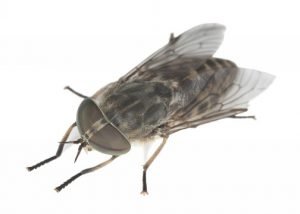
Deer Flies and Horse Flies
- Deer flies and Horse flies are small, ranging from ¾ to 1 ¼ inches as adults. They have an arched thoracic region, and wings that are large and fan-shaped. They are often found near bodies of water where their larvae grow.Both species of flies can be found throughout most of the North America, but their bites do not appear to transmit diseases here. Their bites can cause blood loss, up to 1 cc of blood for their meal. It has been calculated that 20 to 30 of these flies can consume up 20 teaspoons of blood within 6 hours.
Their bites are painful
They are attracted by movement, shiny surfaces, carbon dioxide and warmth. Their bites are painful and generally elicit the victim to move from the area, which will force them to find another food source.
When going to an area where Deer flies and Horse flies are known to inhabit the area wear light colored clothing, neck covering and protective mesh outdoor wear. These protective measures will provide some valuable protection in reducing the annoyance and bites.
Symptoms
Deer Flies and Horse typically bite near the head or face. Their bites leave a small puncture wound, and can result in anything from slight swelling to a swollen bump the size of a golf ball. Other symptoms can include headaches, nausea, fever, and swollen lymph nodes.
Treatment
Apply ice to the area for fifteen minute intervals to reduce swelling from a black fly bite. You can apply cortisone or prescription topical steroids to the affected area. Washing the area with soap and water can reduce the risk of infection.
Fleas are tiny, irritating insects. Their bites are itchy and sometimes painful, and getting rid of them is hard. Sometimes professional pest control treatment may be required.
Fleas reproduce quickly, especially if you have pets in the household.
But even if you don’t have pets, your yard can potentially play host to fleas, and you may end up with a bunch of mysterious bites.
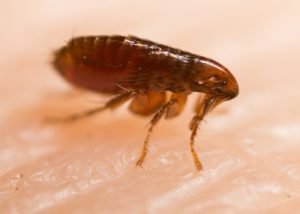
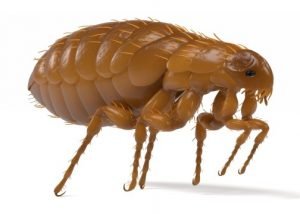
What do Flea Bites look like?
- Fleabites are pretty distinctive. They remain small, unlike mosquito bites. If a flea bites you, you may see one or more of the following:
- bites that appear as small, red bumps
- a red “halo” around the bite center
- bites in groups of three or four, or in a straight lines
- bites that appear around the ankles or legs
- Fleabites are also common around the waist, armpits, breasts, groin, or in the folds of the elbows and knees.
What are the symptoms of a fleabite?
- Fleabites exhibit several common symptoms. They are very itchy, and the skin around each bite may become sore or painful. And you may experience hives or develop a rash near the site of a bite.
- Additionally, excessive scratching can further damage the skin and a secondary bacterial infection can develop.
- Avoid scratching if you can, and monitor your bite areas for signs of an infection, including white-topped blisters or a rash.
Chiggers are tiny larvae members of the arachnid family and are sometimes called red bugs. Although the larvae are extremely small in size, their bites pack a powerful punch. They’re so tiny that you probably won’t notice when they jump from that tall blade of grass onto your skin. You won’t feel it as they hitch a ride right into your home. When you eventually do feel them, however, they can be extremely itchy.


Chiggers Habitat
- Chiggers live in tall weeds and grass, in berry patches, and in wooded areas. They may be in your backyard, by the lake, and clustered along your favorite hiking trail. They are most active on spring, summer and fall afternoons, when temperatures are warm and inviting.
- They can quickly attach to your skin if you walk by and brush up against vegetation where they live. When the temperature falls below 60˚F (16˚C), chiggers become inactive. They die off when the temperature falls below 42˚F (6˚C)
Symptoms of Chigger Bites
- Usually several chiggers are able to latch onto a person walking through an infected area. When the chigger falls off, you are left with reddish bumps. You may notice a bright red dot in the center — this is a remnant of the tube your skin formed in response to the chigger’s saliva. The bumps may look like welts, blisters, pimples, or hives.
- Chiggers can stay latched to the same spot for several days, and it’s common to be bitten by more than one. So bites will generally appear in groups and get larger for several days to a week.
- Many insects tend to bite exposed skin that’s easy to get to. Chiggers like to bite in folds of skin as well as places where clothing fits tightly. Most chigger bites occur around the ankles, waist, armpits, crotch, or behind the knees.
- You won’t feel it when the chigger latches on, and you probably won’t feel a thing when it bites. However, most people report symptoms within hours of the bite. The most problematic symptom of chigger bites is the intense itching and desire to scratch. Chigger bites on the penis can cause severe itching, swelling, and painful urination.
How to treat Chigger bites
- It can take anywhere from one to three weeks for chigger bites to heal. If you suspect you have chigger bites, immediately wash with soap and water. This will get rid of any remaining chiggers on your body. Then apply an antiseptic to any welts.
- In the meantime, try to avoid scratching, as this can cause infection. You may use over-the-counter anti-itch medications like hydrocortisone cream or calamine lotion. You can also apply ice to the bites to relieve the itch.
- Avoid very hot baths and showers. If you become infected or symptoms don’t improve, see your doctor. It’s a common misperception that chiggers burrow under the skin. They don’t, so there is no need to try to remove them.
Health risks of Chigger bites
- Chigger bites are uncomfortable, itchy, annoying, and can make it difficult to sleep. In most cases, chigger bites don’t cause any harm to your health. Chiggers feed on skin cells, but not on blood. They don’t carry or transmit disease.
- However, chigger bites can become infected from too much scratching. Notify your doctor if you have swelling, fever, or other signs of infection.
They’re attracted to people and their four-legged pets, and they can easily move between the two. If you’ve spent any time outdoors, you’ve likely encountered ticks at some point.
Ticks are small, blood-sucking bugs. They can range in size from as small as a pin’s head to as large as a pencil eraser. Ticks have eight legs. They’re arachnids, which means they’re related to spiders. The different kinds of ticks can range in color from shades of brown to reddish brown and black.
As they take in more blood, ticks grow. At their largest, ticks can be about the size of a marble. After a tick has been feeding on its host for several days, they become engorged and can turn a greenish blue color.


Symptoms of Tick Bites
- Tick bites are often harmless, in which case they don’t cause any noticeable symptoms.However, ticks can cause allergic reactions, and certain ticks can pass diseases onto humans and pets when they bite. These can be dangerous or even deadly.Learn how to recognize ticks, the symptoms of tick-borne illnesses, and what to do if a tick bites you.Tick bites are usually harmless and may produce no symptoms.However, if you’re allergic to tick bites, you may experience:
- pain or swelling at the bite site
- a rash
- a burning sensational the bite site
- blisters
- difficulty breathing, if severe
Some ticks carry diseases
- Some ticks carry diseases, which can be passed on when they bite. Tick-borne diseases can cause a variety of symptoms and usually develop within several days to a few weeks after a tick bite. Potential symptoms of tick-borne diseases include:
- a red spot or rash near the bite site
- a full body rash
- neck stiffness
- a headache
- nausea
- weakness
- muscle or joint painor achiness
- a fever
- chills
- swollen lymph nodes
Be sure to seek medical attention as soon as possible if bitten by a tick in order to be evaluated for any potential treatment.
Your AR ant Pest Control office has products developed for the control of pests such as Ants. Due to the potential danger of property damage, it is advisable to contact an AR Service Representative at (905) 670-7378 or info@arpestcontrol.ca
Contact us for no obligation, no hassle, best price quote at (905)670-7378
Get in Touch
AR Pest Control offers residential, commercial, industrial and large multi-unit residential clients with free written quotations without you having to wait days for a return call or an email. Contact us for a no obligation, no hassle, best price quote at (905) 670-7378
AR Pest Control
6355 Kennedy Road, Unit #1 Mississauga, ON L5T 2L5
Find Us on Map
Residential
905-670-7378
Toll Free
1-855-670-7378
Commercial
416-432-2900
Our Email
info@arpestcontrol.ca
Let's Talk About Your Needs
After we get some information from you, we’ll set up a time to discuss your pest control needs in further detail.


